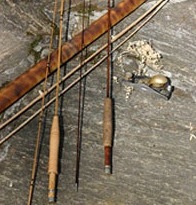 The process of split-cane bamboo rod making can be very challenging. One of the many challenges that face a new rod maker is acquiring the tools and supplies required to practice the craft. While todayŐs maker has an advantage over someone who decided to start making rods ten years ago, it can still be rather difficult, although one recent change has been the development of a small industry that has begun manufacturing rod making equipment and tools.
The process of split-cane bamboo rod making can be very challenging. One of the many challenges that face a new rod maker is acquiring the tools and supplies required to practice the craft. While todayŐs maker has an advantage over someone who decided to start making rods ten years ago, it can still be rather difficult, although one recent change has been the development of a small industry that has begun manufacturing rod making equipment and tools.
In the past, pretty much all rod making equipment was manufactured in a garage or small home shop in the same fashion that you would have built the tool if you had the time. In essence, it was still a homemade tool. Today, however, many individuals have set up very sophisticated operations that create vastly improved equipment over what was once available. In fact, there is now equipment that will allow a rod maker to produce bamboo strips for a rod that are within a tolerance of less that a thousandth of an inch in one pass on an automated machine. This can save about 50 hours of hand planing.
This process brings to mind the difference between a rod maker and a rod builder. A rod maker actually creates the rod blank that is used, while a rod builder purchases a blank and completes it, almost like buying and finishing a rod in kit form. This may sound like a small thing to quibble over, but trust me, if you spend 40 to 50 hours hand planing the bamboo strips for your rod, you will know it is a very important difference.
Another change that has come about recently is the greater availability of necessary supplies. Highland Woodworking, although not specializing in rod making supplies, has among its general woodworking products an outstanding selection of adhesives, finishes and other specialty supplies greatly desired by the rod making community. Among them are hand planes and scrapers made by Lie-Nielson, plane blades by Ron Hock, URAC Glue by Nelson, Titebond extended glues and Devon Epoxies that are often used for mounting ferrules. In addition, Highland stocks imported Japanese waterstones, Tormek sharpening systems, rod making books, finishes by Varathane, Man O War spar varnishes by McCloskey, Transtint Dyes, Ceramithane Finish with Sun Screens, Waterlox Tung Oil finishes, Hydrocote Polyurethane, Japan Dryers, and of course, all the standard items like sandpaper, etc.
Our own Doug Hall, Highland Woodworking's Educational Director, is always willing to share his expertise on the craft of rod making. He will teach a
FREE DEMO
on rod making at our Atlanta store on Saturday, June 14 at 10 AM ET.